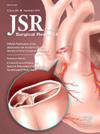Leadership Development and Its Association With Retention of Surgical Versus Nonsurgical Faculty at a Large Academic Health Center
IF 1.8
3区 医学
Q2 SURGERY
引用次数: 0
Abstract
Introduction
Leadership development programs are the key for engaging physicians as partners in health-care administration. These programs have become common; however, one potential consequence of leadership training is attrition.
Methods
Using a prospectively collected database, Kaplan–Meier curves were used to analyze attrition of physician faculty following an intramural leadership program at an academic health center.
Results
Six cohorts totaling 165 faculty successfully completed our leadership program. Sixty-one faculty (37%) were from surgical departments (Group A) and 104 (63%) from nonsurgical departments (Group B). Thirty-six program graduates (21.8%) departed the institution at a mean follow-up of 68 mo for an annualized attrition rate of 3.6%. Attrition rates for Group B were significantly greater than for Group A (P = 0.05). Most faculty left for career advancement opportunities elsewhere.
Conclusions
Our annualized attrition rate for leadership trained faculty was 3.6%, well below the attrition rate of our academic health center (5.3%) over a similar time period, and the 2018 national physician attrition rate of 7.8%. Strategies to improve retention are discussed.
领导力发展及其与大型学术健康中心外科与非外科教职员工留任的关系。
导言:领导力培养计划是让医生作为合作伙伴参与医疗管理的关键。然而,领导力培训的一个潜在后果是自然减员:方法:利用前瞻性收集的数据库,采用 Kaplan-Meier 曲线来分析一个学术健康中心在开展校内领导力项目后医生教员的自然减员情况:结果:六批共 165 名教师成功完成了领导力项目。61名教师(37%)来自外科部门(A组),104名(63%)来自非外科部门(B组)。36 名项目毕业生(21.8%)在平均 68 个月的随访期间离开了学校,年流失率为 3.6%。B 组的流失率明显高于 A 组(P = 0.05)。大多数教职员工离开是为了获得其他地方的职业发展机会:我们接受过领导力培训的教职员工的年自然减员率为 3.6%,远低于我们学术健康中心在类似时期的自然减员率(5.3%)和 2018 年全国医生自然减员率(7.8%)。本文讨论了提高留任率的策略。
本文章由计算机程序翻译,如有差异,请以英文原文为准。
求助全文
约1分钟内获得全文
求助全文
来源期刊
CiteScore
3.90
自引率
4.50%
发文量
627
审稿时长
138 days
期刊介绍:
The Journal of Surgical Research: Clinical and Laboratory Investigation publishes original articles concerned with clinical and laboratory investigations relevant to surgical practice and teaching. The journal emphasizes reports of clinical investigations or fundamental research bearing directly on surgical management that will be of general interest to a broad range of surgeons and surgical researchers. The articles presented need not have been the products of surgeons or of surgical laboratories.
The Journal of Surgical Research also features review articles and special articles relating to educational, research, or social issues of interest to the academic surgical community.

 求助内容:
求助内容: 应助结果提醒方式:
应助结果提醒方式:


